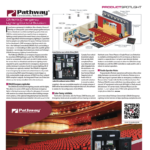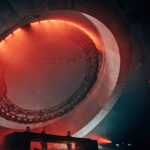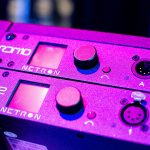When the company that paved the road for the era of automated lighting and drove down the highway of that technology on cruise control for more than 25 years suddenly takes a left turn at the intersection of LED Boulevard and Automated Lighting Way, it's bound to turn some heads. That's essentially what Vari-Lite did last year when they launched the VLX, an automated color wash fixture with an LED light engine under the hood. Vari-Lite was not exactly the first to go down this road, but what they have done is to hit the accelerator and shifted into a higher gear.
Typical Housing, Atypical Light
The VLX looks to all the world like a typical moving yoke fixture. It stands 27.4 inches (69.6cm) high and the yoke is about 17.5 inches (44.5cm) wide, while the base has a footprint of 18.2 inches (46.2cm) by 16.6 inches (42.2cm). But when you pick it up (it weighs 62 pounds, which is much lighter than most moving lights of this size), or look at the lens array at the front of the fixture, you know right away it's no ordinary automated light. Behind the array of small lenses, you can see a cluster of seven circular reflectors that hint at the modular nature of the solid-state light engines inside of the head. Those modules are the heart of the fixture.
Each module has a custom Luminus Devices chipset with one red, one blue, one green and one white LED with a combined power of 120 watts. On the back of the chipset is mounted a fairly sizeable heat sink and an axial fan. Because there are seven modules and six fans (the center module is cooled by the six fans around it and it has a bigger heat sink) plus two more fans in the upper enclosure, there are four modes of operation that affect the fan speed and noise: normal (fan speed varies according to the junction temperature of the LEDs); quiet (LED output levels are decreased to keep LED junction temperatures lower and fan noise to a minimum; constant (fans run at maximum speed regardless of LED junction temperatures; and level light (maintains constant but reduced LED output to keep various fixtures from operating at different levels depending upon thermal situations).
On the opposite side of the chipset, a hexagonal glass light guide is inserted between the output of the LEDs and an aluminum-coated polycarbonate reflector. The glass rod acts as a homogenizer, combining the individual colors of the chipset to produce a single unified beam of light. The reflector at the end of the module then spreads the beam before it goes through the lens array. The seven modules are clustered in an arrangement that creates the signature look of the fixture with six modules encircling a single module in the center.
The final component of the optical system is the zoom. It has two lens plates stacked on top of each other, each of which is the diameter of the snoot of the fixture. Both of these have several very small lenses molded into a polycarbonate substrate. When the plates move towards each other the field angle narrows and when they move away from each other the field widens. The zoom ranges from 23° to 58°.
Surprising Output
The combined output of the seven modules, according to Vari-Lite's photometric data, is about 14,000 lumens. We didn't measure the light output, but we did get a side-by-side comparison with two different Vari-Lite fixtures; the VL500 Wash and the VL2500 Wash. What we saw was pleasantly surprising.
First, the light output of the LED fixture is higher than both of the other two fixtures. A couple of years ago, to read a statement like that would have been extremely difficult to believe. But light output is no longer a barrier to entry for LEDs in the theatrical production industry. The field of the fixture appeared to be nice and wide, very uniform and with no apparent artifacts of non-uniformities.
Second, the color rendering is spectacular. The demonstration put on by the Vari-Lite folks included the side-by-side illumination of two small figurines of a clown and two bouquets of colorful flowers against a large white cyc. All the colors on the clown and in the bouquet appeared very natural and compared very favorably with the identical objects illuminated by the tungsten source. One of the Vari-Lite people strolled into the light of the two fixtures and the skin tones, again, compared very favorably.
Third, the dimming curve in the fixture might be one of the smoothest, if not the smoothest, in the industry. Up until the latest software version, that was not the case. In fact, the last time we had the opportunity to demo the fixture, it was in the prototype stage, and the dimmer was one of the weakest points of the fixture. But that has now been resolved to a commendable degree.
Vibrant Colors
The colors in the fixture look to be typical of an LED color wash fixture. It can produce some very vibrant colors, but the gamut is somewhat limited, especially in the deep blue and forest green ranges. But there's something about the white light and its variable color temperature that makes the subject really pop. In the side-by-side comparisons. there were several times when the color temperature was varied and the subject looks much more crisp and sharp than its twin in the tungsten light or in the arc light. And of course, the color can snap in the VLX from red to green to blue in a fraction of a second, producing some incredible color strobing. Plus, the intensity of the light makes the white light strobe very effective.
As a final test, we pulled out the iPhone to shoot a short segment of video and watch for flicker problems. It's a quick and dirty way to see what the naked eye can't. If flickering is going to show up anywhere, it will be on an inexpensive digital video recorder before it will show up on a high quality one. In this case, there was no evidence of any flicker.
The advantages of LED fixtures are well documented – high efficacy, low power consumption, low heat, long life, low operating costs – but the disadvantages are less publicized. Manufacturers of LED fixtures aren't fond of talking about color rendering, dimming, flicker, cost, or the light output of LEDs as compared to discharge lamps. But in the case of the VLX it seems that they have conquered every one of these issues. In the side-by-side comparisons, it fared extremely well. Now it's up to you to put it to the real world test.


